APPENDIX A
Suppliers and Sources
This appendix presents information about where you can go for further information of some of the many Arduino compatible boards, sensors, components, and other peripheral devices as well as QRP transceivers and other equipment of interest to hams.
Parts and Component Suppliers
Cooking Hacks
This company supplies several different types of shields, including a GPS module pictured here.

We’re including it here because we know you readers will think of some clever use for it that we didn’t have the time or space to devote to it. The web site also provides a tutorial on using the module as well as downloadable software for testing purposes (http://www.cooking-hacks.com).
DFRobot
As you might guess, this company has a lot of products that tie into the robotics field plus a boatload of sensors and shields. However, the shield pictured below is what brought this company to our attention. This is a really clever piece of engineering and is perfect for integration projects where you want multiple shields driven by a single μC. The Arduino Mega-multi Expansion shield means that you can plug four different shields at the same time. All I/O pins of the Mega board are expanded so that you can plug up to four shields and not have to worry about the I/O line conflicts. Although it’s hard to see in the figure below, all of the I/O and other lines are clearly silk screened onto the board, which makes integrating this board a snap. Well worth a look if your project requires multiple shields or you think it might grow to that state.
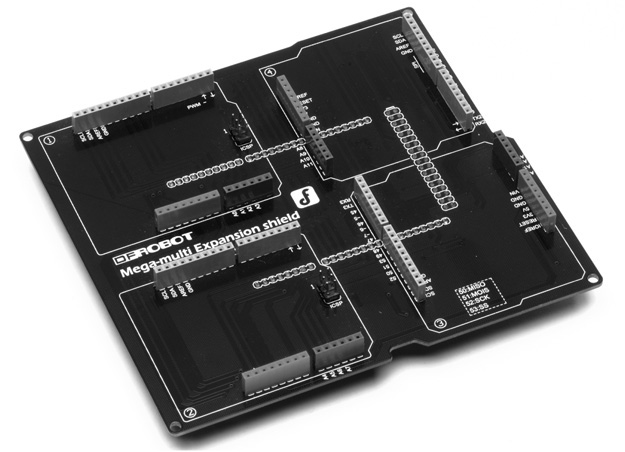
The company can be found at http://www.dfrobot.com.
Diligent Inc.
The Uno32 board takes advantage of the powerful PIC32MX320F128 μC. This μC features a 32-bit MIPS processor core running at 80 MHz, 128K of Flash program memory, and 16K of SRAM data memory. There is a modified IDE that is an Arduino lookalike and is available for Windows, Mac, and Linux. (The board supports all three.) The modified IDE can be downloaded free. For additional platform-specific support for your chipKIT, visit:http://www.chipkit.org/forum/. We have tried numerous sketches and all ran without modification on the chipKIT.
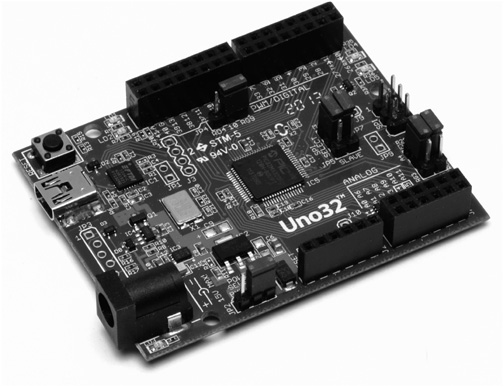
However, the compiler has some differences … all of them good! For example, an int data type for this board uses 4 bytes of storage and a double is 8 bytes, versus 2 and 4 for most Atmel boards. Depending upon your app, this could be a real plus in terms of range and precision. If you need a bunch of I/O lines and a very fast processor, this is a great choice and clearly worth investigating. We also found the placement of the reset button very convenient. Also, this is the board upon which the TEN-TEC Rebel is based. For information, check http://www.digilentinc.com.
Linksprite Technologies Inc.
Until we started this project, we were not aware of this company … our bad. This company supplies some very sophisticated sensors, proto and screw shields, camera, lighting, and other types of electronic devices and components. They have some nice project enclosures, too, and are the manufacturer of the case used for the Dummy Load project. The drive controller for a stepper motor is shown below. Compared to other motor drivers we’ve used, this one’s built like a tank.
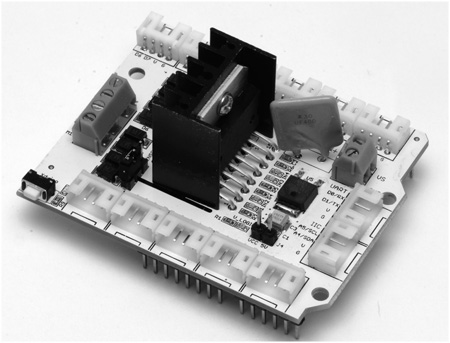
However, as impressed as we were with the motor shield, it was the pcDuino that blew us away. We were expecting another μC. Wrong. The pcDuino is a complete computer with USB inputs for mouse and keyboard, 1 Gb of DRAM, 2 Gb of Flash memory, HDMI video interface, onboard SD card slot, network interface with RJ45 and USB WiFi Dongle, and an ARM CPU clocked at 1 GHz … 16 times faster than an Arduino, with support for Linus or Android OS. We include it here because you can interface Arduino compatible shields to the pcDuino.

We’ve seen a number of posts on Arduino forums that needed a faster processing speed because sensor data was coming in faster than they could process them. Our guess is that this board may be their answer. The price is around $60. More information can be obtained at http://www.pcduino.com. To view the Linksprite product line go to http://www.linksprite.com.
OSEPP
The company offers a number of Arduino compatible boards and sensors. The board received was the OSEPP Mega 2560 R3 Plus, as seen in the photo below. The board is well constructed and is designed to easily attach external devices and sensors. (Notice the mini-USB connector on the left edge of the board plus the Molex connector in the top left corner for connecting to Osepp sensors and I2C devices.) This series features 256K of Flash memory, 8K of SRAM, 4K EEPROM, 54 digital I/O pins, and 16 analog pins.

You can get further information at http://osepp.com.
Pololu Robotic and Electronics
As their name suggests, this company is a great source for electronics in general, but especially motors and sensors. The stepper motor used to rotate the solar panel shown in Chapter 17 is a NEMA 17 supplied by Pololu. The company also manufactures numerous types of sensors, relay, and other types of boards that would be of interest to hams. Their quality is excellent and good delivery times and service (http://www.pololu.com).
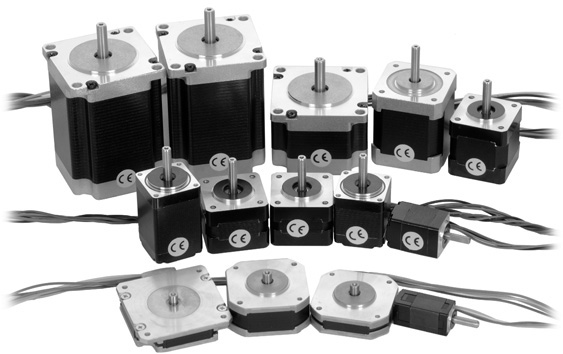
Seeed Studio
Suppliers of many reasonably priced μC boards and shields. They submitted their Seeed Mega 2560 and SD shield for evaluation. Their 2560 Mega board has one of the smallest footprints we’ve seen for this board. We have also used several of their other shields, including their SD shield (with micro adapter), and everything has been of very high quality and performed as advertised. They also offer a proto shield kit designed specifically for their Mega board. The kit comes with just about all headers and pins you’ll ever need to use the shield.
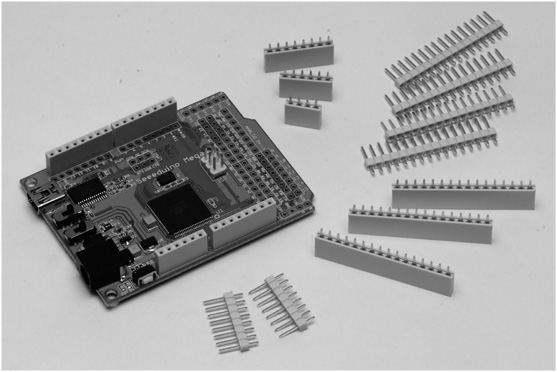
Web: http://www.seeedstudio.com
Tinyos Electronics
This company has a 2560Mega compatible board, but also supplied us with an ATmega328 board. As you can see relative to the pen cap in the photo below, this is one of the smallest boards we received, but it ran all sketches perfectly. The board is well constructed and reasonably priced. Also note that the microcontroller chip is removable. This means you could load software onto the board, remove the chip, and place it in a bare-bones board with only a chip and a few other components if you wanted to do so.

They also sell a wide variety of shields, sensors, and other products for the Arduino boards. I used this board a lot while writing this book, mainly because of its size. For further information, visit http://tinyosshop.com.
Transceiver and Device Suppliers
Blekokqrp 40 meters SSB/CW Transceiver
This transceiver is amazingly small (approximately 2.75 in. × 5.25 in.) yet has a 2–4 W output signal on both SSB and CW. It can be adjusted between 7.0 and 7.3 MHz with an internal ferrite adjustment or 170 kHz with the supplied pot. The rig is a semi-kit in that the onboard parts are already mounted and only the external controls need to be added. Jumpers and connectors are supplied. This is a very nice kit at a very affordable price of around $75 (http://blekokqrp.blogspot.com).
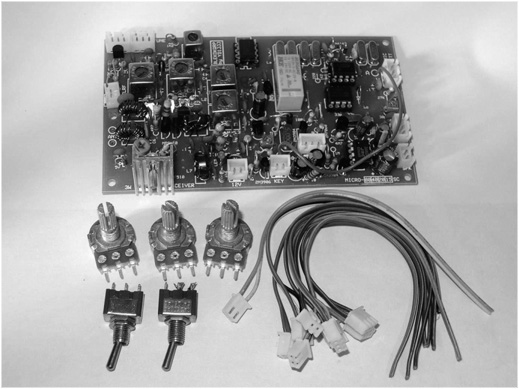
CRK-10A CW and KN-Q7A SSB Transceivers
The CRK-10A transceiver kit can be ordered for 40 meters or 20 meters. We received an assembled version ($70), but the manufacturer states that the kit ($55) can be completed in 4 hours. The instruction manual is extremely well written, so we do think the kit can be built in 4 hours. It includes CQ memory and has an RF output of about 3 W at 12 V. Power supply range is 9 to 15 V. TX current is about 500 mA, and RX current is about 15 mA (measured at 12 V). The built-in MCU (12F629) can generate side tone of about 700 Hz, switch RX/TX, and act as a keyer for not only paddle (normal paddle or bug key simulation mode), but also straight key.
The receiver is a direct conversion receiver, but the sensitivity is very good because of a two-pole crystal filter in the receiver front-end and an audio filter, which block interference and filter out background noise. The MCU automatically shifts TX frequency, generates side tone and acts as the keyer, which makes the whole radio quite practical. The power supply polarity protection and the high SWR protection make the radio durable.
While most of the narrative above is taken from their advertising literature, we were stunned at the receiver’s sensitivity. If you’re looking for a rig that’s about the size of a deck of cards and relatively inexpensive, this is a great choice, especially with the addition of the VFO and LCD frequency display projects added. We really had fun with this rig!

You can read the construction manual at http://crkits.com/crk10amanual.pdf.
The KN-Q7A is an 8-10 W SSB transceiver that can be ordered for either the 40 meter or 20 meter bands.
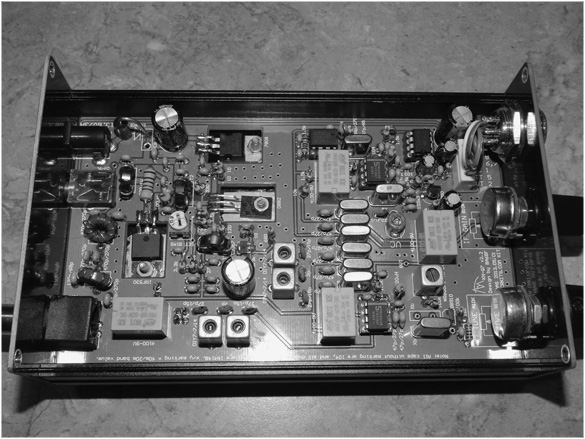
The transceiver is a little larger than the CRK-10A and requires a heftier power supply. This receiver is also a hot performer and the power output is more than adequate to punch through the QRM on either band. The 40 meter band can be ordered with frequency segment slices that fit your favorite frequencies, which span about 20 kHz. The 20 meters version spectrum slice is fixed at 14.200 to 14.230 MHz. The kit is available for $115 while the assembled version is $165. We would suggest ordering their mic, as it works well with the rig. We also found Larry, the rep for the US distributor, very helpful and quick to respond to questions. The US distributor can be contacted at http://www.larvell.net.
Iambino and Peaberry
This is a clever combination of several useful ham devices. Not only is it an Arduino compatible LCD shield, it also features a DAC, speaker, radio output, pot, and a professional-quality keyer kit.

All the code controlling the device is General Public License (GPL) so you can access and read the code at https://github.com/AE9RB/iambino.
The Peaberry SDR V2 kit is a Software Defined Radio using a 96 kHz digital I/Q interface common to most SDRs. There are several things that make the Peaberry different from other SDR kits. First, you select the band combinations (e.g., 160/80/75, 60/40/30/20) you want at construction time. All parts are included with the kit. Second, all ADC and DAC circuits are included, so you don’t need to add sound cards to your computer. Finally, the firmware is Open Source, allowing you to modify it if you wish. (The picture is shown with the optional acrylic case.) For current prices and order information, see http://AE9RB.com.
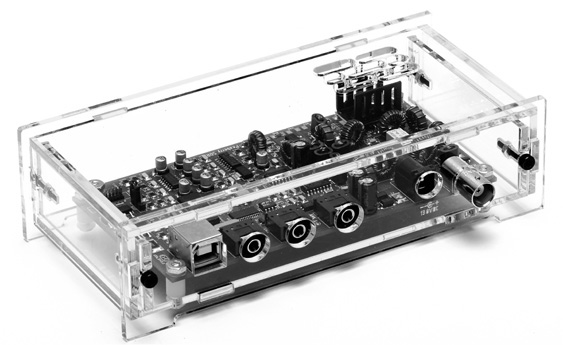
MFJ Enterprises
MFJ has a number of Cub kits available for 80, 40, 30, 20, 17, or 15 meters. Some of the specs are: 0.2 μV receiver sensitivity, crystal filter and shaped audio, differential-mode AGC, good AF output for phones or speaker, adjustable transmitter with RF output is variable from zero to 2 W out through 20 meters (1 W on 17/15 meters), full QSK, sidetone, shaped keying, 36 mA receive, 380 mA transmit using any regulated 12-15 VDC power source.
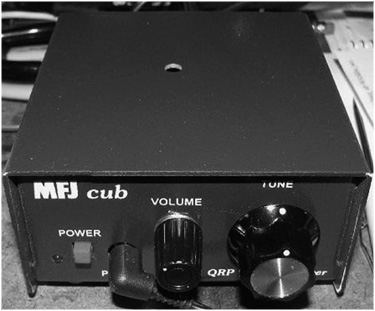
Prices are $100 for the kit versions and $150 completely assembled (http://www.mfjenterprises.com).
ozQRP MST2 SSB Transceiver Kits
The ozQRP MST2 series are 5W SSB transceiver kits configurable for operation on 80 meters, 40 meters, or 20 meters. The transceivers feature a sensitive superhet receiver with a 5-pole crystal filter, very effective AGC, and built-in tone generator for antenna tuner adjustment. The IC’s are pre-mounted SMDs on the 165 mm × 110 mm PCB. The board with all onboard components sells for $85. A DDS VFO kit specifically designed for the MST2 features a rotary encoder for frequency selection that is displayed on a 2 × 16 LCD. The display also shows current voltage and adjustable frequency step value and is available for $65. Finally, an innovative LED S meter kit accurately displays receiver S units and output power on a 7-segment bar graph for $30. Kits are complete except for enclosure (requires metal rear panel as heat sink for PA) and external controls and connectors. All three kits can be purchased for $170.
I (Jack) received this late in the book writing, but I’m really glad I had a chance to use it. I received the 20 meters version, virtually identical to the one pictured below. This is a very nice rig. The receiver works well and the LCD display is easy to read. The signal strength/output indicator adds a touch not found on most QRP rigs and is surprisingly useful. I was able to make SSB contacts on both coasts with a Hamstick vertical dipole! This is a (non-opal) little gem from down under. Comprehensive construction manuals plus more helpful information is available at www.ozqrp.com.
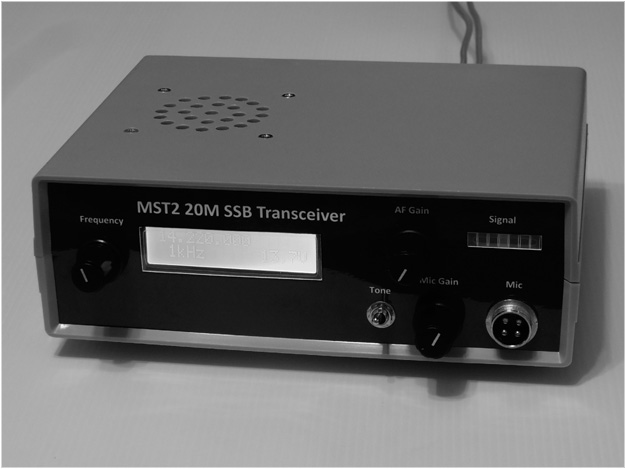
TEN-TEC
TEN-TEC manufactures a complete line of QRP CW transceivers for the 20, 30, 40, or 80 meter bands. Each features about 3 W power output, QSK, and can cover a 50 kHz segment determined by you at the time of construction. Kit includes all required components and professional silk screened and painted enclosure. Single conversion superhet receiver performance is superlative and QSK is just what you expect from the hams at TEN-TEC. Each kit is priced at less than $125.00. We were impressed with the performance of the 1300 series.
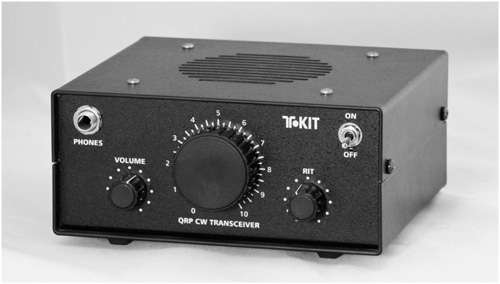
TEN-TEC is not sitting on its laurels, however, as evidenced by their new Rebel transceiver. The most interesting part of the Rebel is that it is controlled by the chipKIT Uno32 microcontroller chip from Digilent. Designed for 40 and 20 meters the Rebel defaults to 7.030 MHz or 14.060 MHz on start-up. However, since the Uno32 is running the show, you can reprogram it to alter the way frequencies are managed. Software changes can be made using the free IDE provided by Digilent. The Rebel has a USB port for uploading software changes. Inside, TEN-TEC has made it very easy to fiddle with the Uno32 by providing two rows of headers, which align with an Arduino-type shield. There are also convenient tie points for reading battery voltage, RF power, CW, and CW speed. We started playing around with the Rebel source code and in less than 25 minutes, we interfaced the LCD display from Chapter 3 into the Rebel, as can be seen in the figure below.
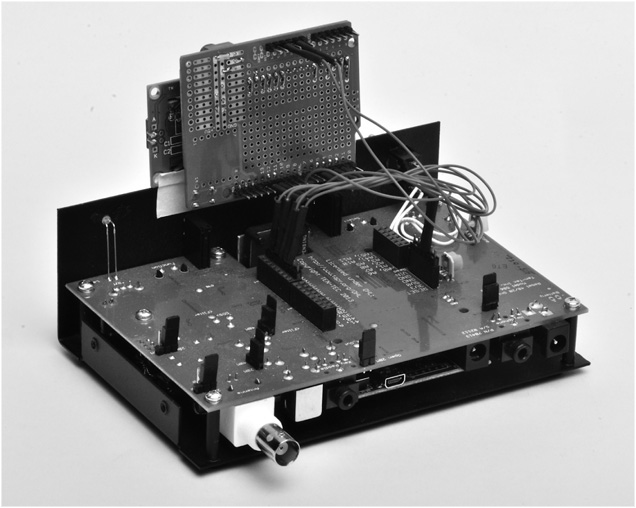

We think hams will have a lot of fun with this one! We also think this design will be more and more popular in the future as hams discover what hardware/software marriages bring to the table. The price for the Rebel is $200.
TEN-TEC announced the Patriot at the 2014 Dayton Hamfest. The rig is so new that we do not have the full specs on it yet. However, it has coverage of 40 to 20 meters on both SSB and CW without bandswitch jumpers, is Open Source using the chipKIT Uno32 like the Rebel, and had a DDS VFO. We believe the market price will be around $400. For complete info, contact http://www.tentec.com.
Small Wonder Labs
This company produces the Rock-Mite CW transceiver kit. As you can see in the figure below, the transceiver is quite small, yet has a surprising number of features, many of which exist because of the 8-pin PIC microcontroller onboard. It has a built-in Iambic keyer, automatic T/R switching, 700 Hz sidetone, and a half-watt output with a 12 V source. It’s available for 80, 40, 30, and 20 meters with calling frequency choices. The price is $40! The Rock-Mite series is now distributed by http://www.qrpme.com/.
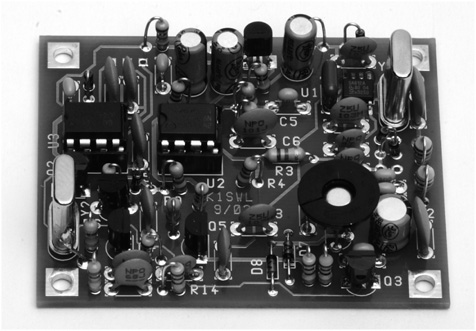
UL-Solar
This is the 10 W, 12 V solar panel that is used in Chapter 17. The panel is roughly 14 in. × 12 in. × 1 in. and weighs 3.11 lb, which is lighter than some other 10 W panels we’ve seen. The cells are polycrystalline and have a 10 year limited warranty of 90% output and 25 years at 80% output. The suggested retail price is $49.95, although we’ve seen them on sale for a little less than that. They also carry larger panels up to 210 W at 24 V, plus various types of mounting hardware. For more information, see http://www.ul-solar.com/.
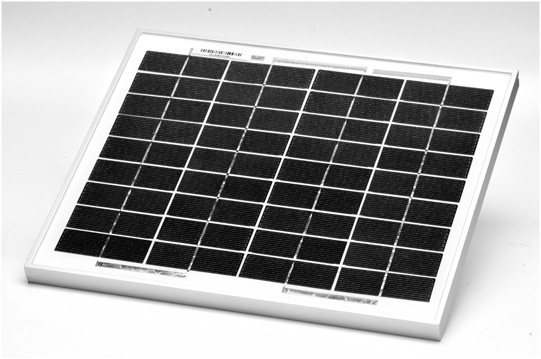
Amateur Radio Equipment Retailers
These are the major retailers of amateur radio gear in the United States. They are a great source for the radio-related odds and ends that you can’t obtain from other sources. All three provide international service.
Amateur Electronics Supply. Internet sales and 4 retail stores. http://www.aesham.com
Ham Radio Outlet. Internet sales and 12 retail stores. http://www.hamradio.com
R&L Electronics. Internet and retail sales located in Hamilton, OH. http://www.randl.com
Texas Towers. Internet and retail sales in Plano, TX. http://www.texastowers.com
Universal Radio. Internet and retail store located in Rynoldsbur, OH. http://www.universal-radio.com
Test and Measurement Equipment
These days there are many companies producing test equipment and if you are on a tight budget, look for older, used test equipment to suit your needs at a local ham flea market or on eBay. Names from the past like Heathkit, Eico, and Knight Kit are available for modest expenditure through eBay. Look for Hewlett-Packard (Agilent), Tektronix, and other high end equipment there as well. These manufacturers provide the tools that we use today:
Agilent Technologies. Formerly branded as Hewlett-Packard and “spun off” in 1999, this company has been a premier provider of test and measurement equipment since 1939. http://www.agilent.com
B&K Precision. Affordable, broad range gear such as multimeters, generators, power supplies, frequency counters, and oscilloscopes. http://www.bkprecision.com
Fluke. Digital multimeters and portable oscilloscopes. http://en-us.fluke.com
Rigol. Good quality, low cost lab equipment such as oscilloscopes, spectrum analyzers, power supplies, and multimeters. http://www.rigol.com
Tektronix. Another major US test equipment manufacturer. Founded in 1946. http://www.tek.com
Other Suppliers and Sources
There are a number of places where you can go to purchase electronic components for your projects. Some of the ones we have used are listed below. You should also use eBay as a source and a reference for parts. With almost 100 purchases there, including many foreign suppliers, we have never had a problem.
Adafruit Industries. Suppliers of both hardware (shields) and software, plus a number of good tutorials on how to use their products. http://www.adafruit.com.
All Electronics. Component Supplier. Worth getting on their email list for special deals. http://www.allelectronics.com
Allied Electronics. Component supplier. No minimum order. http://www.alliedelec.com
Antique Electronics Supply. Good source for carbon composition resistors and other hard-to-find parts. http://www.tubesandmore.com
Debco Electronics. Component supplier. Small distributor run by husband-wife team, both hams. Strong on ICs, custom made cables, RF connectors. Like an old hardware store with hundreds of parts bins … fun place to visit. Fast mail order and reasonable prices on small orders. http://www.debcoelectronics.com
Digi-Key Electronics. Component supplier. No minimum order. http://www.digikey.com
Intertex Electronics. Source for the Philmore microphone connectors used in the Directional Coupler / SWR Indicator project. http://intertexelectronics.com
Jameco Electronics. Component supplier. http://www.jameco.com
Martin P Jones & Associates. Component supplier. Monthly email specials are interesting, and they are a good source for all components including power supplies. They are one of the best sources for project cases that we have found. http://www.mpja.com
Mouser Electronics. Component supplier. No minimum order. http://www.mouser.com
Newark. Component supplier. No minimum order. http://www.newark.com
Parts Express. Components and specials. Good source for project cases. http://www.parts-express.com
Radio Shack. Component Supplier. Great for when you forgot to order that one part that makes it all work. http://www.radioshack.com
